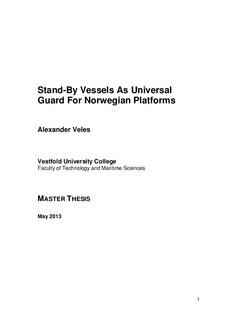| dc.description.abstract | Safety stand-by vessels are one of the resources with which people who have ended up in the water can be rescued. The Emergency Response Plan defines the number of safety stand-by vessels that should be in the direct vicinity of the offshore installation at any given point, to be able to comply with the 20+20 and 120+20 minute requirements. Not every sea going vessel is suitable to act as a safety standby vessel. Design and construction of safety stand-by vessels has evolved rapidly and continues to do so with new types, new technology and new roles coming to the forefront, although a number of challenges remain. Also there are special standards and requirements, as well as certifications for stand-by vessels. Typically of our work is that in spite of the standards stand-by vessels are different from each other and there is an assumption that this difference affect the effectiveness of the emergency response. The purpose of this work is to determine the most suitable stand-by vessel from a technical perspective in order to improve the level of platforms guard. | |
